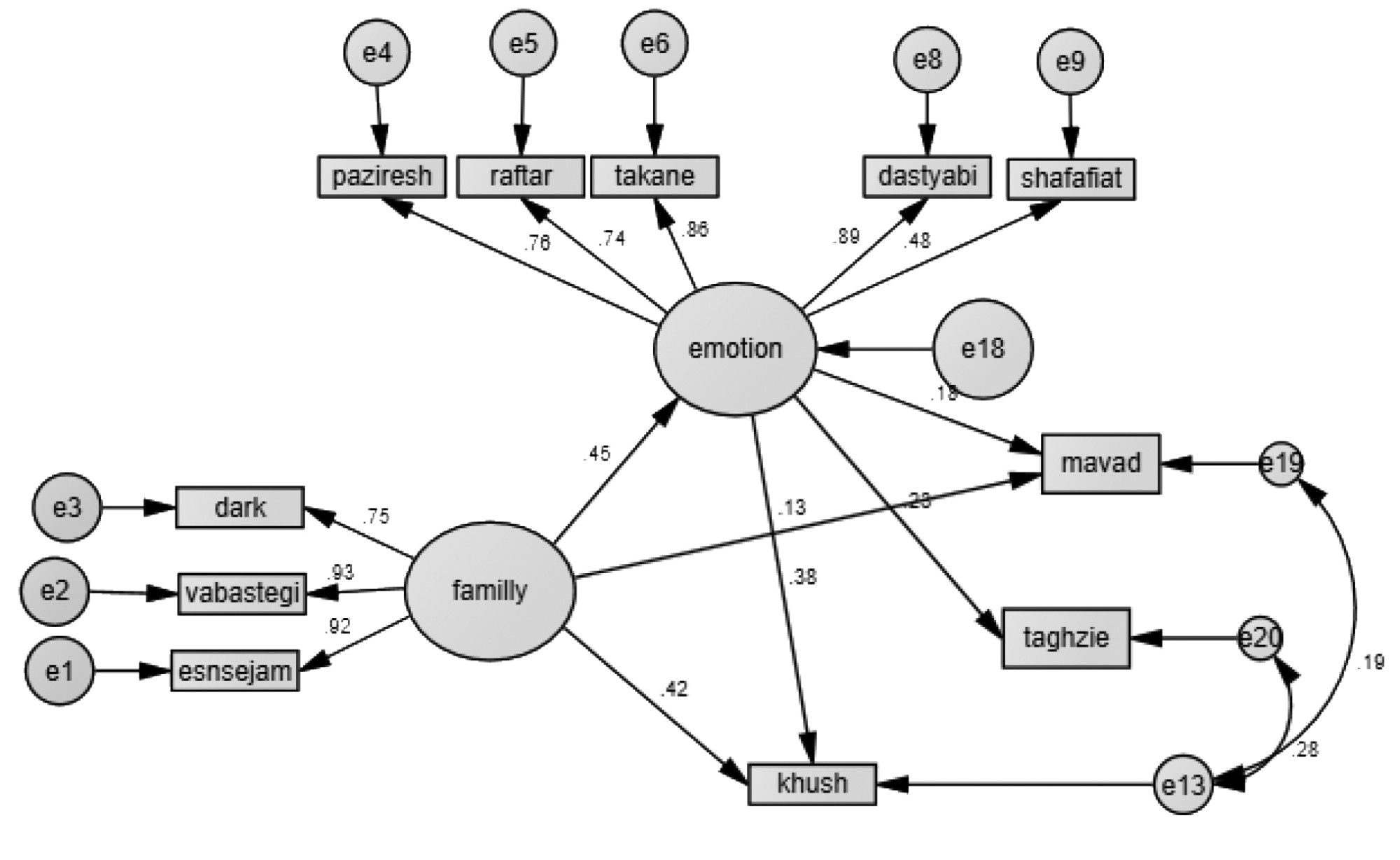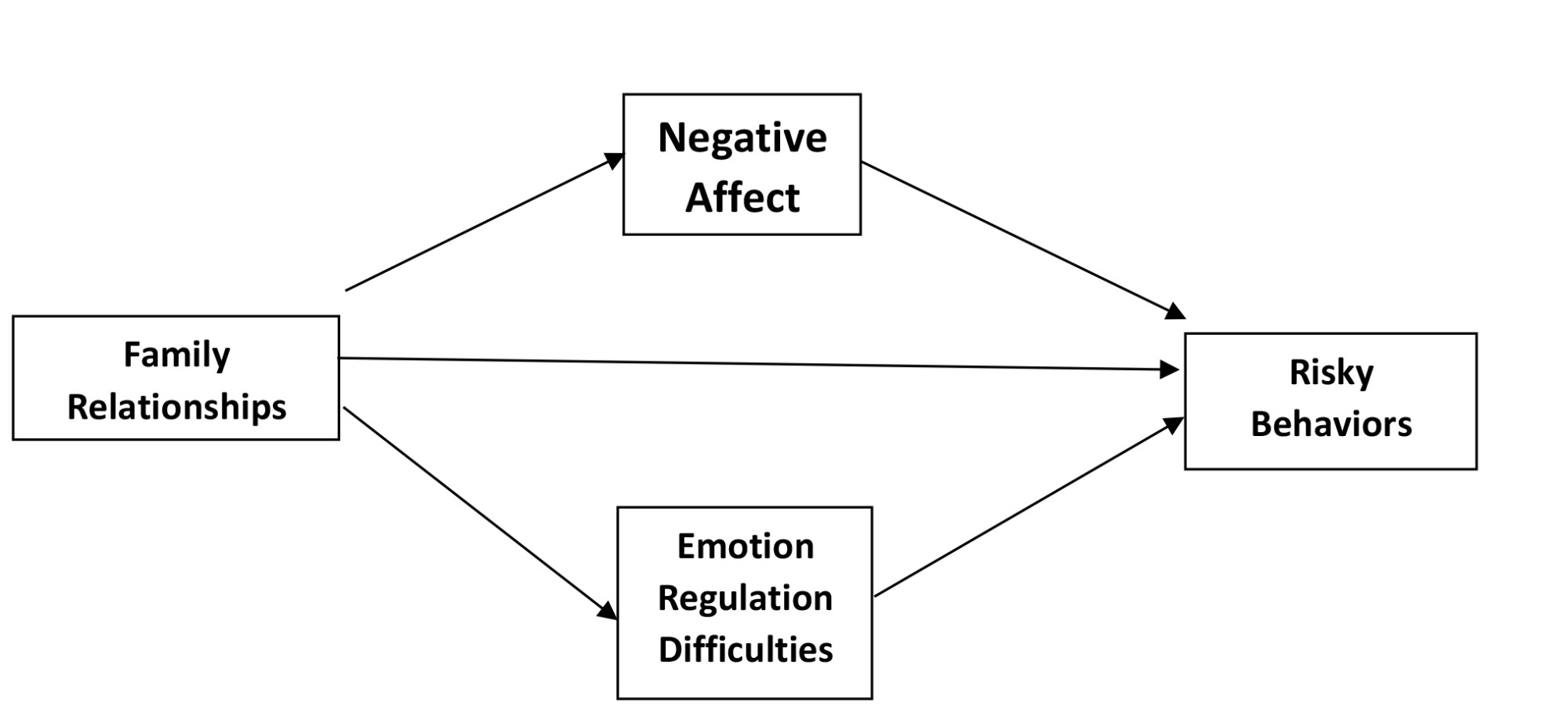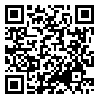Volume 21, Issue 80 (4-2021)
refahj 2021, 21(80): 147-169 |
Back to browse issues page
Download citation:
BibTeX | RIS | EndNote | Medlars | ProCite | Reference Manager | RefWorks
Send citation to:



BibTeX | RIS | EndNote | Medlars | ProCite | Reference Manager | RefWorks
Send citation to:
goodarzi M, Mohammadi M, aslezakerlighvan M, Rahmati F. (2021). Investigation of the Relationship between Family Relationship Styles and Risky Behaviors: The Mediating Role of Negative Affect and Emotion Regulation Difficulties. refahj. 21(80), 147-169.
URL: http://refahj.uswr.ac.ir/article-1-3580-en.html
URL: http://refahj.uswr.ac.ir/article-1-3580-en.html
Keywords: Risky behavior, Family relationship index, Emotion regulation difficulties, Negative affect
Full-Text [PDF 774 kb]
(2164 Downloads)
| Abstract (HTML) (4210 Views)
Full-Text: (555 Views)
Extended Abstract
Introduction: Risky behavior refers to a set of behaviors that threaten one’s health and well-being or make them vulnerable to serious injuries such as dangerous illnesses and even early death. According to a report in the US, substance use, alcohol abuse, and high-risk sexual behaviors were found to respectively account for 0.02, 0.07, and 0.04 early illness and death. Also, the consequences of such behaviors are likely to hurt others in a wider range.
The prevalence of risky behavior such as smoking has increased compared to previous studies (13.4% to 39.9% among men, 0.07% to 25.5% among women). Therefore, the effective factors impacting this issue should be to investigated.
Several related studies suggest that disruptive family relationships, which include interconnectedness, inflexibility, and lack of cohesion, predict risky decisions and behaviors. Furthermore, conflict resolution styles in family relationships are associated with the lack of awareness and psychological skills. Negative affect and emotion regulation difficulties are the common examples.
Negative affect refers to a state of unpleasant internal discomfort. High scores on this scale correlated with impulsive behaviors, sexual high-risk behaviors, and the intensity of other high-risk behaviors
Besides, the emotion regulation difficulties refer to the inability to adjust to negative emotions and it leads to the use of ineffective coping strategies. Emotion regulation difficulties have also played a mediating role in childhood painful experiences with substance use, violence, and high-risk sexual behaviors, but these studies are generally limited to drug abuse or sexual abuse.
Research in the field of family relationships has focused more on traumatic experiences and less research has been conducted on the effect of family relationships, such as conflict, emotional expression, and family cohesion. Therefore, the purpose of the present study is to investigate the relationship between family relationships style and high-risk behaviors through negative affect and emotional regulation.
Participants include 366 university students studying in different universities in Tehran. They were selected by convenience sampling and were asked to respond to family relationship index, positive and negative Effects, difficulties in emotion regulation, and risky behavior questionnaires. They were analyzed by Spss-22 and Amos-21 software.
Measures
Family relationship index (FRI):
This questionnaire contains 27 items designed to measure the overall quality of the family environment. The questionnaire consists of three subscales: family cohesion, emotional expression, and family conflict. Cronbach’s alpha for Iranian items were 0.93.
Difficulties in emotion regulation scale (DERS):
The Difficulties in Emotion Regulation Scale consist of 36 items. It was formulated to evaluate the difficulty in emotional regulation. The factor analysis results confirm the existence of six factors: rejection of emotional responses, difficulty in purposeful behavior, impulse control difficulty, lack of emotional awareness, limited access to emotion regulation strategies, and lack of emotional clarity. All the six subscales of this questionnaire have a Cronbach’s alpha value above 0.80. Based on the validation study in Iran, Cronbach’s alpha was 0.92.
Positive and negative affect scale (PANAS):
The scale is a 20-item self-assessment scale designed to measure two affective dimensions of negative and positive affect; the reliability of test-retest was 0.68.
Iranian validation showed that the questionnaire has good fit indexes and high internal consistency (Cronbach’s alpha = 0.87).
Risky Behaviors Questionnaire (RBQ):
This questionnaire was developed to assess six sets of high-risk behaviors and consist of 61 items. Its Cronbach’s alpha was 0.81. The subscales of this questionnaire include addiction and substance abuse, AIDS, tobacco use, violence, alcohol abuse, and unhealthy eating patterns.
Results:
Pearson correlation test results showed that there are significant correlations between Family Relationships with negative affect, emotional regulation difficulties, and high-risk behaviors. In other words, the more the people’s level of misunderstanding, the less the cohesion and dependency relationship in a family, the more they are likely to experience emotion regulation difficulties and risky behaviors.
Table 1: Correlation between Family relationships, Negative affect and Emotion regulation
**p<0.001 *p<0.01
To investigate the model, Amos-21 was performed using the maximum likelihood analysis method. family relationships, Negative Affect and Emotion Regulation Difficulties were considered unobserved variables. .
Table 2: Conceptual model fit indices
Model fit indices show that the proposed model has a good fit. Family relationship directly and significantly predicts difficulty in emotion regulation (Beta = 0.45 p <0.001). In other words, people with a lack of coherence and higher conflicts in families are more likely to experience difficulty in emotion regulation, and vice versa. The results of the conceptual model also showed that family-style directly and significantly predicts high-risk behaviors of substance use (beta = 0.13, p <0.001) and violence (beta = 0.42, p <0.001). This means that people living in conflicted families are more likely to engage in risky substance abuse and violent behaviors in the future.
Also, the results of the conceptual analysis of the structural model showed that family styles can predict high-risk behaviors such as substance abuse, eating behaviors, and violence through difficulty in emotion regulation. In other words, difficulty in emotion regulation has a mediating role between family relationship variables with substance use, eating behavior, and violence.
A part of the results of the analysis of the proposed conceptual model showed that negative emotions could not mediate between family relationships and high-risk behaviors. Therefore, difficulties in emotion regulation were only mediated by family relationship, and three subscales of high-risk behaviors and other subscales were not predicted by family relationship and emotion regulation difficulties. Discussion:
Discussion:
The major aim of the study was to investigate the mediating role of negative affect and difficulty in emotion regulation concerning family relationships and high-risk behaviors.
The results of the correlation analysis showed that family relationship has a significant positive relationship with difficulty in emotion regulation, high-risk behavior, and negative affect. As shown by the results family relationship predicts subscales of high-risk behavior including violence, drugs, and eating behaviors. Both directly and through difficulty in emotion regulation. The results of the study are in line with Lansing’s (2019) study on the relationship between difficulties in emotion regulation with high-risk behaviors. Another study by Mandavia et al. (2016) showed that exposure to childhood abuse is linked to substance use in adulthood through difficulty in emotion regulation. Consistent with these studies, Ebrahimi’s (2017) study showed that family-style predicts risky decisions and behaviors.
People with less understanding, cohesion, and dependency in the family, may be deprived of primary emotional education and support that caregivers can provide them with. They internalized early experiences of problem-solving and dealing with negative emotions in the family. It can be implied that problems are unsolvable and the only way to deal with emotions is to evacuate by non-adaptive strategies.
Also, in the present study, despite the negative emotion research hypothesis, there was no mediating role between family relationship style and high-risk behaviors. Some people may experience more negative emotions, but may recognize, tolerate, or otherwise exhibit symptoms, such as depression and anxiety. As a result, problems in the family environment predict difficulty in emotion regulation and risky behaviors. Accordingly, attention, and evaluation of the role of the vulnerable populations can prevent such behaviors.
Ethical considerations of the authors:
The authors are thankful to all those people who took part in this study. There are no competing financial interests that might create a conflict of interest.
Introduction: Risky behavior refers to a set of behaviors that threaten one’s health and well-being or make them vulnerable to serious injuries such as dangerous illnesses and even early death. According to a report in the US, substance use, alcohol abuse, and high-risk sexual behaviors were found to respectively account for 0.02, 0.07, and 0.04 early illness and death. Also, the consequences of such behaviors are likely to hurt others in a wider range.
The prevalence of risky behavior such as smoking has increased compared to previous studies (13.4% to 39.9% among men, 0.07% to 25.5% among women). Therefore, the effective factors impacting this issue should be to investigated.
Several related studies suggest that disruptive family relationships, which include interconnectedness, inflexibility, and lack of cohesion, predict risky decisions and behaviors. Furthermore, conflict resolution styles in family relationships are associated with the lack of awareness and psychological skills. Negative affect and emotion regulation difficulties are the common examples.
Negative affect refers to a state of unpleasant internal discomfort. High scores on this scale correlated with impulsive behaviors, sexual high-risk behaviors, and the intensity of other high-risk behaviors
Besides, the emotion regulation difficulties refer to the inability to adjust to negative emotions and it leads to the use of ineffective coping strategies. Emotion regulation difficulties have also played a mediating role in childhood painful experiences with substance use, violence, and high-risk sexual behaviors, but these studies are generally limited to drug abuse or sexual abuse.
Research in the field of family relationships has focused more on traumatic experiences and less research has been conducted on the effect of family relationships, such as conflict, emotional expression, and family cohesion. Therefore, the purpose of the present study is to investigate the relationship between family relationships style and high-risk behaviors through negative affect and emotional regulation.
Figure1: The assumed model


Method:
ParticipantsParticipants include 366 university students studying in different universities in Tehran. They were selected by convenience sampling and were asked to respond to family relationship index, positive and negative Effects, difficulties in emotion regulation, and risky behavior questionnaires. They were analyzed by Spss-22 and Amos-21 software.
Measures
Family relationship index (FRI):
This questionnaire contains 27 items designed to measure the overall quality of the family environment. The questionnaire consists of three subscales: family cohesion, emotional expression, and family conflict. Cronbach’s alpha for Iranian items were 0.93.
Difficulties in emotion regulation scale (DERS):
The Difficulties in Emotion Regulation Scale consist of 36 items. It was formulated to evaluate the difficulty in emotional regulation. The factor analysis results confirm the existence of six factors: rejection of emotional responses, difficulty in purposeful behavior, impulse control difficulty, lack of emotional awareness, limited access to emotion regulation strategies, and lack of emotional clarity. All the six subscales of this questionnaire have a Cronbach’s alpha value above 0.80. Based on the validation study in Iran, Cronbach’s alpha was 0.92.
Positive and negative affect scale (PANAS):
The scale is a 20-item self-assessment scale designed to measure two affective dimensions of negative and positive affect; the reliability of test-retest was 0.68.
Iranian validation showed that the questionnaire has good fit indexes and high internal consistency (Cronbach’s alpha = 0.87).
Risky Behaviors Questionnaire (RBQ):
This questionnaire was developed to assess six sets of high-risk behaviors and consist of 61 items. Its Cronbach’s alpha was 0.81. The subscales of this questionnaire include addiction and substance abuse, AIDS, tobacco use, violence, alcohol abuse, and unhealthy eating patterns.
Results:
Pearson correlation test results showed that there are significant correlations between Family Relationships with negative affect, emotional regulation difficulties, and high-risk behaviors. In other words, the more the people’s level of misunderstanding, the less the cohesion and dependency relationship in a family, the more they are likely to experience emotion regulation difficulties and risky behaviors.
Table 1: Correlation between Family relationships, Negative affect and Emotion regulation
| variables | Family relationships | Negative affect | Emotion regulation |
| Family relations | 1 | ||
| Negative affect | 0.16** | 1 | |
| Emotion regulation | 0.35** | 0.36** | 1 |
| Risky behaviors | 0.42** | 0.10** | 0.35** |
To investigate the model, Amos-21 was performed using the maximum likelihood analysis method. family relationships, Negative Affect and Emotion Regulation Difficulties were considered unobserved variables. .
Table 2: Conceptual model fit indices
| P-value | RMSEA* | IFI* | CFI* | χ2/df | Df | χ2 | Model |
| 0.001 | 0.07 | 0.96 | 0.96 | 2.92 | 39 | 113.88 | 1 |
Model fit indices show that the proposed model has a good fit. Family relationship directly and significantly predicts difficulty in emotion regulation (Beta = 0.45 p <0.001). In other words, people with a lack of coherence and higher conflicts in families are more likely to experience difficulty in emotion regulation, and vice versa. The results of the conceptual model also showed that family-style directly and significantly predicts high-risk behaviors of substance use (beta = 0.13, p <0.001) and violence (beta = 0.42, p <0.001). This means that people living in conflicted families are more likely to engage in risky substance abuse and violent behaviors in the future.
Also, the results of the conceptual analysis of the structural model showed that family styles can predict high-risk behaviors such as substance abuse, eating behaviors, and violence through difficulty in emotion regulation. In other words, difficulty in emotion regulation has a mediating role between family relationship variables with substance use, eating behavior, and violence.
A part of the results of the analysis of the proposed conceptual model showed that negative emotions could not mediate between family relationships and high-risk behaviors. Therefore, difficulties in emotion regulation were only mediated by family relationship, and three subscales of high-risk behaviors and other subscales were not predicted by family relationship and emotion regulation difficulties.
Figure 2: The model

The major aim of the study was to investigate the mediating role of negative affect and difficulty in emotion regulation concerning family relationships and high-risk behaviors.
The results of the correlation analysis showed that family relationship has a significant positive relationship with difficulty in emotion regulation, high-risk behavior, and negative affect. As shown by the results family relationship predicts subscales of high-risk behavior including violence, drugs, and eating behaviors. Both directly and through difficulty in emotion regulation. The results of the study are in line with Lansing’s (2019) study on the relationship between difficulties in emotion regulation with high-risk behaviors. Another study by Mandavia et al. (2016) showed that exposure to childhood abuse is linked to substance use in adulthood through difficulty in emotion regulation. Consistent with these studies, Ebrahimi’s (2017) study showed that family-style predicts risky decisions and behaviors.
People with less understanding, cohesion, and dependency in the family, may be deprived of primary emotional education and support that caregivers can provide them with. They internalized early experiences of problem-solving and dealing with negative emotions in the family. It can be implied that problems are unsolvable and the only way to deal with emotions is to evacuate by non-adaptive strategies.
Also, in the present study, despite the negative emotion research hypothesis, there was no mediating role between family relationship style and high-risk behaviors. Some people may experience more negative emotions, but may recognize, tolerate, or otherwise exhibit symptoms, such as depression and anxiety. As a result, problems in the family environment predict difficulty in emotion regulation and risky behaviors. Accordingly, attention, and evaluation of the role of the vulnerable populations can prevent such behaviors.
Ethical considerations of the authors:
The authors are thankful to all those people who took part in this study. There are no competing financial interests that might create a conflict of interest.
Type of Study: orginal |
Received: 2020/02/9 | Accepted: 2021/01/20 | Published: 2021/05/17
Received: 2020/02/9 | Accepted: 2021/01/20 | Published: 2021/05/17
Send email to the article author
| Rights and permissions | |
 |
This work is licensed under a Creative Commons Attribution-NonCommercial 4.0 International License. |







